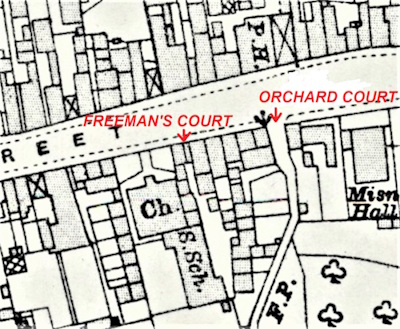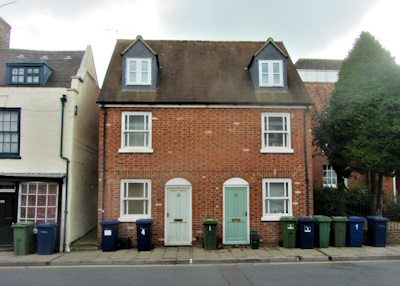The Lost Freemans Court
to Expand
Alfred was, tragically, in the news again in 1937, when he fell off a roof and died. The circumstances caused some concern at his inquest, because earlier in the day he’d been hit on the head by a length of falling rainwater spout. He was replacing a tile on a house in Mill Street when the fatal accident happened. A week or so earlier, whilst the large German gun in Victoria Gardens, a trophy from the Great War, was being dismantled for scrap a heavy metal spring flew off it, hit the roof and broke the tile. Alfred was, indirectly, maybe the last victim of the war. The inquest verdict was Accidental Death.
Oddly, the residents were serial mushroom thieves. In 1927, Fredrick Curtis was caught in a hay field in Twyning, on his bicycle with a basket of mushrooms. He was fined 10 shillings for mushroom theft, plus 5 shillings for damaging the grass. In 1935 Ray and Daisy Hodges were fined 5 shillings each for taking mushrooms from a Pamington field. Three years later. Ray was caught again, in Aston on Carrant. This time he was sentenced to 14 days incarceration. Mushroom theft was taken seriously.
As regards Council intervention, the court had a quiet life. There were none of the problems which other areas had with water and sanitation, nor any of the serious social problems which came from overcrowding. That might be because of the attitude of the landlord towards their tenants, and the standards they maintained. This didn’t save the houses, though. In November 1937, the Court came into the sights of the Sanitary Committee for clearance. In December the landlord confirmed that they could not economically renovate the houses, and so their fate was sealed. Clearance and demolition orders progressed through their many stages and by May 1939 the houses were demolished, leaving the court area empty for many years, with a gap in the street frontage, until in 2007 the incongruously-named Cotswold Cottages filled it, filling the space which was once Freeman’s Court for ever, and erasing the Freeman name.

Freeman’s Court disappeared in 1939. It used to a space between what is now the Kingdom Hall of the Jehovah’s Witnesses and the back of Orchard Court. Apart from the ‘front houses’ the court contained six cottages and a bacon curing factory.
The court is named for William Freeman. He was brother of George, the lace-making entrepreneur who had built the factory which is now North East Terrace, where he made his fortune. William was his factory manager. Some time before 1849, when alley names were made permanent, William had bought the six houses, so the court was named for him. In 1853 he sold them to the next-door Independent Chapel for £10, so that they would have a regular income from the rents. This was a philanthropic, not a commercial, decision. Both brothers attended the chapel. Two of the houses disappeared sometime after 1851. There seem to be no clues as to why.
The residents of the Court were generally unskilled labourers who often stayed there for decades; a quite settled community. Things happened occasionally, and it is mostly their misdemeanours which have been recorded. These are not often of a serious nature.
In 1913, Alfred Earthridge was fined for fishing with two rods when he only had one licence. In 1923 he appeared in court again. This time he was a witness in a case involving the Nottingham Arms, who contended that the ‘Electra-Amuser’ slot machine they had installed in the pub was not primarily for gambling. His evidence was that the optional small electric shocks it gave had a welcome therapeutic effect on his shell-shock, and winning prizes was irrelevant. The judge would have none of it, though, and the landlord was fined £5.
Census Data 1841-1891
- Lewington?
- Humphries



Comments
Sunday 23-Jun-2024 by: John Dixon
David Aldred has written two articles on the Freeman textile brothers in THS Bulletins 23 & 24.